Nestled amidst the Sahyadri Hills in Maharashtra, India, Lohagad Fort stands as a majestic symbol of history, resilience, and architectural brilliance. With a history spanning over two millennia, this hill fortress is a testament to India’s rich cultural heritage and strategic significance.
Follow archeology.dulichvn.net to learn more about mysterious artifacts.

History of Lohagad Fort
Origins in the Satavahana Period
Lohagad Fort’s origins trace back to the 1st-2nd Century BC, during the reign of the Satavahana dynasty, one of the earliest and most influential powers in ancient India. Built as a hill fortress, it was strategically positioned to oversee vital trade routes that passed through the western Ghats, serving as both a defensive stronghold and a hub for commerce. The fort’s design from this period reflects remarkable engineering techniques, showcasing the Satavahanas’ advanced understanding of fortification.
The fort’s location also reveals their strategic foresight, as it provided a natural vantage point to monitor enemy movements, making it a crucial site in the region’s defense network. This early foundation set the stage for Lohagad to evolve into a key military and trade asset for future rulers.
Role Through Dynasties
Throughout its long history, Lohagad Fort passed through the hands of several powerful dynasties, each contributing to its fortifications and infrastructure. Under the Nizam Shahi rulers of the 14th century, the fort underwent significant expansions, including the addition of new gateways and defensive walls, reinforcing its strategic importance in controlling the surrounding region.
Later, during the Mughal era, the fort became a key military outpost, with the Mughals investing in its maintenance to bolster their empire’s foothold in western India. However, it was under the Maratha Empire that Lohagad truly became renowned. The Marathas recognized the fort’s strategic significance, further enhancing its defenses and turning it into a vital stronghold for their campaigns across the region. Each dynasty that held the fort left behind traces of their rule, making Lohagad a unique blend of architectural styles and historical legacies.
Under Chhatrapati Shivaji Maharaj
In the 17th century, Chhatrapati Shivaji Maharaj, one of India’s greatest warriors and strategists, captured Lohagad Fort as part of his broader efforts to consolidate Maratha power. Recognizing its immense strategic value, Shivaji Maharaj strengthened the fort’s fortifications and used it as a key base for safeguarding his treasure and military supplies.
Lohagad’s location provided Shivaji with an advantageous position to monitor and control the movements of rival forces, and it became a key player in his military campaigns. The fort also served as a symbol of the Maratha Empire’s strength and resilience, standing proudly against invasions and fortifying Shivaji’s vision of an independent Maratha state. To this day, Lohagad remains a revered site in Maratha history, embodying the courage and legacy of Shivaji Maharaj’s reign.
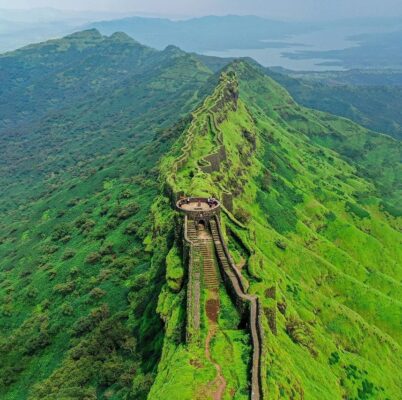
Architectural Features of Lohagad Fort
Massive Stone Walls
Encircling the entirety of Lohagad Fort are its colossal stone walls, a testament to the architectural brilliance and strategic foresight of ancient Indian engineers. These walls, towering and robust, were meticulously constructed to withstand the most formidable sieges and serve as an impenetrable defense against invading forces.
Crafted from locally sourced stone, the walls not only blend seamlessly with the natural landscape but also demonstrate the precision and craftsmanship of their builders. Over centuries, these fortifications have weathered countless battles and the ravages of time, standing as enduring symbols of resilience and strength. Their sheer scale and durability reflect the importance of Lohagad Fort as a military stronghold in safeguarding the region.
Fortified Gateways
Lohagad Fort is renowned for its series of imposing gateways, each serving as both a defensive barrier and an architectural marvel. The most prominent among them are the Ganesh Darwaza, Narayan Darwaza, Hanuman Darwaza, and Maha Darwaza. These gateways are intricately designed, featuring carvings and motifs that highlight the artistic sensibilities of their creators. Their strategic placement and reinforced construction ensured that enemy forces faced multiple layers of resistance before gaining entry.
Each gateway served a distinct purpose in the fort’s defense mechanism. For instance, the Ganesh Darwaza, adorned with images of Lord Ganesha, symbolizes protection and prosperity, while the Hanuman Darwaza pays homage to the deity of strength and courage. The layered approach of these gateways, combined with their narrow passages, allowed defenders to effectively repel attackers, making Lohagad a nearly impenetrable fortress.
Water Cisterns and Reservoirs
A hallmark of Lohagad Fort’s ingenious design is its system of water cisterns and reservoirs, carved directly into the rocky terrain. These structures ensured a reliable supply of water, even during prolonged sieges, highlighting the foresight and planning of its builders. The cisterns, fed by natural springs and rainwater, were strategically placed to serve both the military garrison and the local population.
These reservoirs were not merely functional but also well-engineered to minimize evaporation and maintain water purity. Their construction reflects a deep understanding of hydrology and resource management, essential for sustaining life in a hill fortress. Today, these water systems remain intact, offering visitors a glimpse into the advanced infrastructure that once supported the fort’s inhabitants.
Lohagad Fort’s stone walls, fortified gateways, and ingenious water systems together illustrate the unparalleled skill and strategic acumen of its creators, making it a masterpiece of ancient Indian architecture and military engineering.
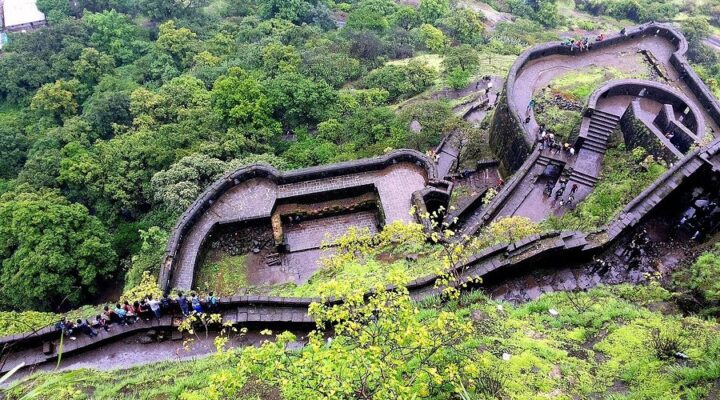
The Vinchu Kata: A Unique Feature
The Scorpion’s Tail: The Unique Vinchu Kata
Among the many fascinating features of Lohagad Fort, the Vinchu Kata stands out as its most iconic and distinctive structure. This long, narrow spur, aptly named for its resemblance to a scorpion’s tail, is a natural extension of the fort that weaves through the rugged terrain of the Sahyadri Hills. Stretching for several kilometers, the Vinchu Kata is not just a marvel of natural topography but also an integral part of the fort’s defensive design. Its serpentine structure provided an additional layer of protection, making it nearly impossible for invaders to approach the main fort unnoticed.
The Vinchu Kata also enhances the fort’s aesthetic appeal, offering an awe-inspiring blend of nature’s beauty and human ingenuity. Standing atop this natural ridge, visitors are treated to panoramic views of the surrounding valleys, forests, and distant hills, making it a visual spectacle and a photographer’s paradise.
A Trekker’s Paradise
For trekkers, the Vinchu Kata is nothing short of a thrilling adventure. Its winding trail, carved through uneven rock formations and bordered by steep drops, offers an exhilarating experience for both seasoned and novice adventurers. The journey across the Vinchu Kata allows trekkers to immerse themselves in the fort’s history while being enveloped by the serene beauty of the Sahyadri landscape.
The trail provides numerous vantage points for breathtaking views, particularly during the monsoon season when the surroundings are lush with greenery, and waterfalls cascade down the cliffs. For those seeking a deeper connection with nature and history, walking along the Vinchu Kata is an unmissable experience that embodies the spirit of exploration and discovery.
Strategic Significance
Historically, the Vinchu Kata was not merely a natural wonder but a crucial element of Lohagad Fort’s military strategy. Its elevated position allowed sentinels to monitor enemy movements from a distance and protect the fort from surprise attacks. The spur’s narrow and winding path made it an effective natural barrier, slowing down approaching forces and giving defenders ample time to respond.
Moreover, the Vinchu Kata served as an ideal vantage point for signaling allied forts in the vicinity, reinforcing the interconnected defensive network of the Maratha Empire. This strategic advantage ensured that Lohagad remained a formidable stronghold for centuries, safeguarding the treasures and territories of its rulers.
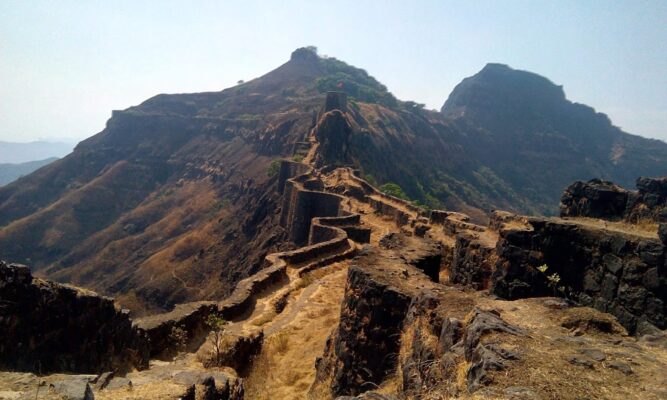
Visiting Lohagad Fort
Accessibility: A Convenient Getaway
Lohagad Fort is a highly accessible destination, conveniently located near major urban centers like Pune (52 km) and Mumbai (110 km). This proximity makes it an ideal day trip or weekend getaway for history buffs, adventure seekers, and nature enthusiasts alike. The most common access point is the base village of Malavli, situated just 7 km from the fort. Malavli is well-connected by rail and road, with frequent trains and buses operating from Pune and Mumbai.
Visitors arriving by train can disembark at Malavli Railway Station, which lies on the Mumbai-Pune railway line. From there, local transport options such as shared jeeps and auto-rickshaws can take you closer to the starting point of the trek. For those driving, ample parking facilities are available near the base, making it a hassle-free journey. The well-marked trekking trail begins at Malavli, winding through picturesque landscapes that set the tone for an unforgettable experience.
The Trekking Experience: A Blend of Adventure and Serenity
The trek to Lohagad Fort is an exhilarating yet beginner-friendly climb, making it accessible to both seasoned trekkers and novices. The trail is moderately challenging, with a mix of rocky paths, steps, and gentle inclines. On average, it takes about 1.5 to 2 hours to reach the fort’s summit, depending on your pace and fitness level.
What sets this trek apart is the breathtaking scenery along the way. During the monsoon season, the route comes alive with lush greenery, cascading waterfalls, and mist-shrouded hills. The rhythmic sound of flowing streams and the cool breeze create an enchanting atmosphere, making the journey as rewarding as the destination. For photography enthusiasts, every twist and turn of the trail offers stunning vistas that capture the beauty of the Western Ghats.
The trail also offers glimpses of local flora and fauna, adding a touch of nature’s charm to your adventure. With several rest stops and shaded areas along the route, the trek is as relaxing as it is invigorating, providing a perfect escape from the hustle and bustle of city life.
Best Time to Visit: When Lohagad Fort Shines
Timing your visit to Lohagad Fort can significantly enhance your experience. The monsoon months (June to September) transform the fort and its surroundings into a lush green paradise. The hills are draped in vibrant foliage, and the occasional drizzle adds a magical touch to the trek. However, the trail can become slippery during heavy rains, so appropriate footwear and caution are advised.
The winter season (October to February) is equally mesmerizing, with cool temperatures and clear skies making the trek enjoyable. During this time, the fort is often enveloped in a veil of mist, creating an ethereal atmosphere. The winter months are perfect for those who prefer a drier trail while still enjoying the scenic beauty.
While summer visits are possible, the heat can be taxing, and the landscape tends to lose some of its vibrancy. Therefore, monsoon and winter are widely regarded as the best times to visit, offering the perfect blend of natural beauty and comfortable trekking conditions.
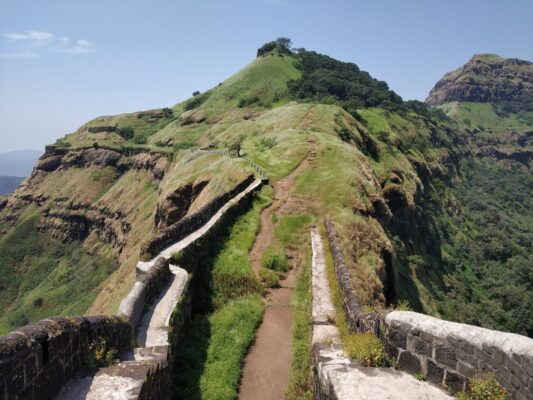
See more: Akhenaten and His Daughter: A Glimpse into Ancient Egypt’s Royal Family
Conclusion
Lohagad Fort is more than just a historical monument; it is a journey through time, showcasing the ingenuity, valor, and cultural richness of India’s past. Whether you’re a history buff, a trekking enthusiast, or a nature lover, this timeless marvel promises an unforgettable experience. Make Lohagad Fort your next destination to witness the confluence of history and nature in its most awe-inspiring form.

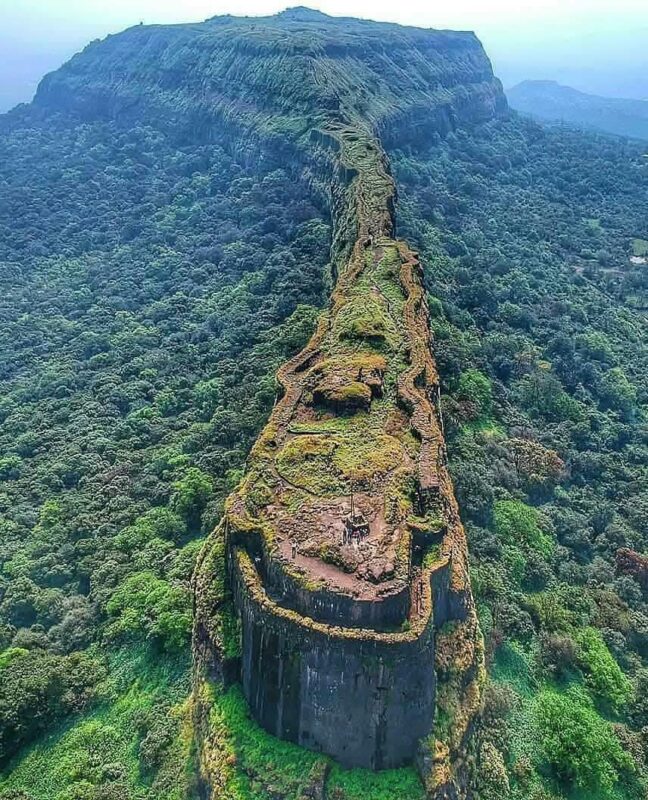
CÁC TIN KHÁC
Mary Walton: The Forgotten Inventor Who Helped Clean Up America’s Cities
Tomb of Queen Nefertari in the Valley of the Queens, Egypt
Discover the Hypostyle Hall of the Temple of Hathor at Dendera
Venus de Losange: Unveiling the Mystery of a 20,000-Year-Old Paleolithic Icon